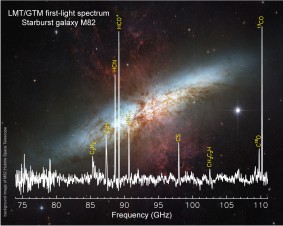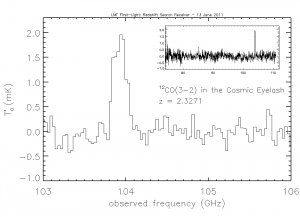
LMT first-light measurements of the broad-band 3mm spectrum of the starburst galaxy M82 using the Redshift Search Receiver in June 2011 (background: HST image of M82).
On June 1, 2011, the LMT achieved first light observations at 3 mm using the Redshift Search Receiver (RSR). The first observed target was Messier 82 (M82), a relatively nearby starburst galaxy at a distance of 12 million light years. This type of galaxy undergoes episodes of intense star formation, which in the case of M82 are induced by the gravitational interaction with its companion galaxy M81. The injection of cold gas towards the central region of the galaxy due to its interaction produces large amounts of infrared and millimeter wavelength radiation, which excites the interstellar medium of M82 and results in the emission of molecular lines. The LMT has detected, in only half hour, a large collection of emission lines produced by organic molecules, some of which cannot be generated by nature on the Earth.
Following the detection of M82, the LMT also measured the mm-wavelength radiation from more distant objects, including the detection of carbon monoxide from the galaxies SMM J2135-0102 (the Cosmic Eyelash) and MM 18423+5938. This rest-frame sub-mm emission was produced when the Universe was only 21 and 12 per cent of its current age respectively. The light from these galaxies is magnified by gravitational lenses in the nearby Universe, massive systems that allow measurements of the amount and distribution of the dark matter.

Fig.1 A 3GHz band-width spectrum of the z=2.327 sub-mm galaxy “Cosmic Eyelash” measured with the RSR on the LMT. The full broad-band 73-111GHz spectrum is shown in the inset figure. The redshifted CO 3-2 line is fully resolved by the RSR.
These first-light observations demonstrated that the scientific requirements of the LMT’s original design are realistic and that, although not yet completely optimized, the LMT has the potential to perform scientific observations with an important impact on our understanding of the Universe at different cosmological epochs.
In addition to the successful measurements with the RSR, observations with the 1.1 mm continuum camera AzTEC and a wide range of engineering observations were also carried out as part of the commissioning and first-light campaign.